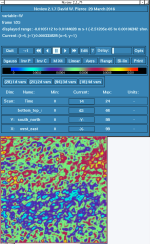A colleague noticed a strange and undesirable behavior in 3.9.1.1 which I was able to reproduce in 4.1.3. Briefly, waves with a wavelength of about 2km appear in the upper part of the domain when we set a constant dz there, but apparently not when dz keeps changing (and also dz > dx). The waves can reach amplitudes of +/-30m/s, depending inversely on the time step, i.e., larger amplitude for smaller time step. An example is attached where dx=500m, dt=1s, and dz_top=700m. There is no thermal perturbation in the domain, so these grow purely from noise or something else.
For the same sounding, a constantly-changing dz does *not* result in these waves (second plot of W, with max value ~1mm/s), and also a larger time step makes them much smaller. A plot comparing two sets of dz and eta levels is also attached. There is also a layer of constant dz at the surface, but nothing obvious happens there, perhaps because dz < dx.
Looks like some kind of pathology, but we are stumped as to what. It seems not to care about 6th-order filtering or km_opt (it's in a stable layer). There is no obvious physical reason for constant dz to be a problem.
I can supply wrfinputs/wrfouts for these for testing, too. I used a customized ideal init routine to use designated z-levels for initialization. We get the same results if the same eta levels are used with the default WK sounding.
Any ideas? For the time being we will probably just not use constant dz at top.
Thanks,
Ted Mansell (and Derek Stratman)
For the same sounding, a constantly-changing dz does *not* result in these waves (second plot of W, with max value ~1mm/s), and also a larger time step makes them much smaller. A plot comparing two sets of dz and eta levels is also attached. There is also a layer of constant dz at the surface, but nothing obvious happens there, perhaps because dz < dx.
Looks like some kind of pathology, but we are stumped as to what. It seems not to care about 6th-order filtering or km_opt (it's in a stable layer). There is no obvious physical reason for constant dz to be a problem.
I can supply wrfinputs/wrfouts for these for testing, too. I used a customized ideal init routine to use designated z-levels for initialization. We get the same results if the same eta levels are used with the default WK sounding.
Any ideas? For the time being we will probably just not use constant dz at top.
Thanks,
Ted Mansell (and Derek Stratman)


